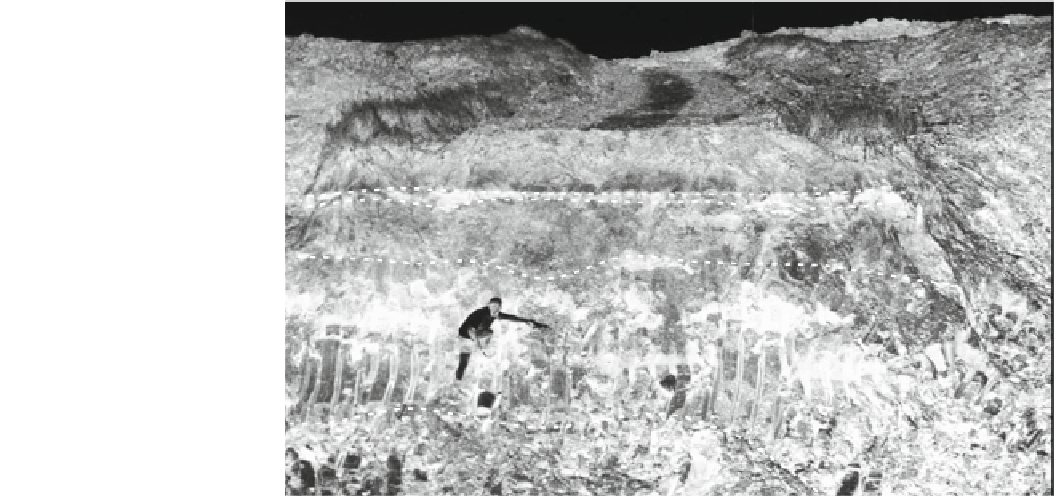Geoscience Reference
In-Depth Information
Fig. 4.2
Section through the
barrier beach at Bellambi, New
South Wales, Australia: a modern
dune, b Holocene barrier sand
dated using thermoluminescence
(TL) at 7,400 BP, c clay unit,
d tsunami sand TL—dated at
25,000 BP, e Holocene estuarine
clay radiocarbon dated at 5,100
BP, and f Pleistocene estuarine
clay TL—dated at more than
45000 years in age. The TL date
of the tsunami sand indicates that
the sands are anomalous. The
Holocene ages overlap
a
b
c
d
e
f
4.4.1
Sandy Barrier Coasts
the Papua New Guinea Tsunami of July 17, 1998 (Kawata
et al.
1999
). The emplacement of a sand deposit overtop
lagoonal sediments on a coastline with stable sea level may
signify the presence of recent tsunami where historical
evidence for such events is lacking. Pre-existing tidal inlets
are preferred conduits for tsunami. Sediment-laden tsunami
may deposit large, coherent deltas at these locations, and
these may be mistaken for flood tidal deltas (Minoura and
Nakaya
1991
; Andrade
1992
). These features may be raised
above present sea level or form shallow shoals inside inlets.
Because the sediment was deposited rapidly, these deltas
may end abruptly landward in lagoons and estuaries,
forming sediment thresholds that are stable under present-
day tidal flow regimes. Channels through the lagoon can
also be scoured by tsunami, with sediment being deposited
on the landward side of lagoons as splays.
If the volume of sand transported by a tsunami is large,
then a raised backbarrier platform may form from coa-
lescing overwash fans or smaller lagoons may be com-
pletely infilled. The height of either the backbarrier
platform or infilled lagoon may lie several meters above
existing sea level. These raised lagoons may be misinter-
preted as evidence for a higher sea level. If these surfaces
are not covered by seawater or quickly vegetated, they may
be subject to wind deflation, with the formation of small
hummocky dunes. Under extreme conditions, tsunami
waves may cross a lagoon, overwash the landward shore-
line, and deposit marine sediment as chenier ridges. Such
ridges ring the landward sides of lagoons in New South
Wales. Finally, along ria coastlines, estuaries may be in-
filled with marine sediment for considerable distances up-
river. High-velocity flood and backwash flows under large
tsunami may form pool and riffle topography. This process
Large sections of the world's sandy coastline are charac-
terized by barriers either welded to the coastline or sepa-
rated from it by shallow lagoons. The origin of these
barriers has been attributed to shoreward movement of
sediment across the shelf by wind-generated waves, con-
comitantly with the Holocene rise of sea level (Komar
1998
). Lagoons form where the rate of migration of sand
deposits lags the rate at which the rising sea drowns land.
This theory of barrier formation ignores the role of tsunami
as a possible mechanism, not only for shifting barriers
landward, but also for building them up vertically. For
example, at Bellambi along the New South Wales coast of
Australia, tsunami-deposited sands make up 20-90 % of the
vertical accretion of a barrier beach that stands 3-4 m above
present sea level (Fig.
4.2
). This beach will be described in
more detail subsequently (Young et al.
1995
).
Tsunami in shallow water are constructional waves with
the potential to carry large amounts of sand and coarse-
grained sediment shoreward. Large aeolian dunes that may
develop on stable barriers do not necessary impede tsunami
(Minoura and Nakaya
1991
; Andrade
1992
). Instead, tsu-
nami can overwash such forms, reducing the height of the
dunes, depositing sediment in dune hollows, and spreading
sand as a thin sheet across backing lagoons (Fig.
4.3
). On
the other hand, storm waves tend to surge through low-lying
gaps in dune fields, sporadically depositing lobate washover
fans in lagoons (Bryant and McCann
1973
). Rarely will
these fans penetrate far into a lagoon or coalesce. The
seaward part of the barrier can also be translated rapidly
landward tens of meters by the passage of a tsunami. This
occurred along the barrier fronting Sissano lagoon during









